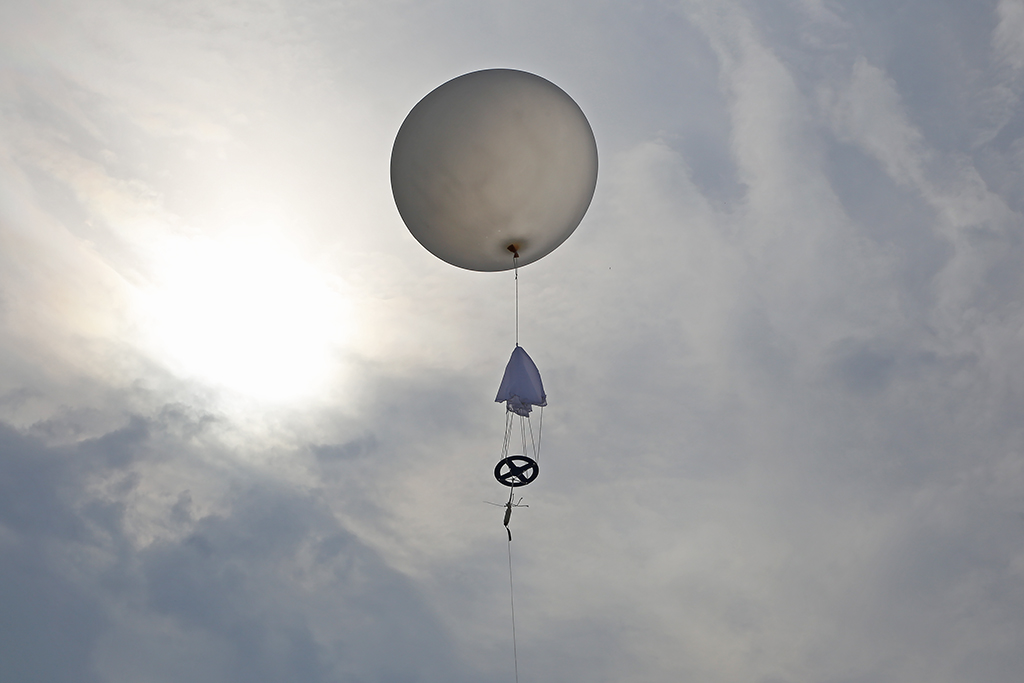UND weather balloon helps with NASA research
David Delene, research professor of Atmospheric Sciences, oversees launch to support NASA snowstorm research

Giant balloons are popping up in the news these days as mysterious objects float across portions of the United States and Canada. Meanwhile, large balloons are drifting across parts of eastern North Dakota and northwestern Minnesota as well, though these balloons weren’t launched from a shadowy location or with a murky purpose. Instead, they rose from a parking lot next to UND’s Clifford Hall — and with the purpose of gathering data for NASA.
The balloons are actually weather balloons, and one of them was launched on the afternoon of Tuesday, Feb. 14 at UND. It was one of a series that were launched by a UND Atmospheric Sciences researcher with some graduate and undergraduate students.
The balloon was designed to gather certain atmospheric data that is to be shared with NASA, for a project that happens only once every few decades.
In 2019, David Delene, research professor of Atmospheric Sciences, was awarded more than $600,000 to participate in the NASA IMPACTS Project (Investigation of Microphysics & Precipitation for Atlantic Coast-Threatening Snowstorms). Winter storms on the eastern seaboard cause serious problems for travel, business and public safety, and snowfall from the storms is organized in banded structures which are neither well-understood nor well-predicted by weather forecasting models. The IMPACT Project is seeking to fill in those gaps in atmospheric knowledge.
The project began in Jan. 2019 and runs through Dec. 2023, though it likely could be extended, Delene said.
“This is a very unique project,” he said. “It’s the third year of the research project, and they only do one of these to study winter storms every 20 or 30 years.”
To assist NASA, Delene and the group of students headed out to the parking lot to release the weather balloon, which, incidentally, was nowhere near as large as the ominous balloon recently shot down by the U.S. Air Force over the Atlantic Ocean. The launch was a quick and easy procedure: Inflate the balloon with helium, attach a sensor module and let it go. And just like that, it was gone.

Delene said it wasn’t as important as where the balloon flew as the altitude it reached. The sensors were meant to gather certain atmospheric data that preceded the blizzard-like storm that passed through the region the night of Feb. 14 and through the following day.
The balloons aren’t released willy-nilly into the atmosphere. While not required under regulations due to the light weight and size of the balloon (think something you couldn’t quite get your arms around), the UND team filed a “Notice of Essential Information” with flight operations, which included the general direction (north-east) and the altitude range.
And in case you are wondering, those balloons don’t stay in the sky forever:
“It will go up into the stratosphere and then the balloon will pop, and it’ll come down on a parachute,” Delene said.
Shortly after the UND team in Grand Forks launched the weather balloon, a counterpart UND team launched another in Bemidji, Minn., an area closer to the impact of the then-pending blizzard.
But that didn’t mean that UND students were going to keep their feet on the ground. Graduate students Christian Nairy, Jennifer Moore and Michael Willette were standing by to take off in a NASA P-3 aircraft to gather even more sensitive data about snowstorms. Their flight took them on a course between Minneapolis and Grand Rapids in Minnesota.
It wasn’t the first such flight for the graduate students. They’ve flown on the science flights before, and it’s their job to maintain and monitor the sensors attached under the wings of the aircraft, then download and collate that data for NASA researchers. Getting the data isn’t something they can do from the ground, so a NASA pilot takes them to where the real data is: Through a storm front.
Editor’s note: A previous, roller coaster-like flight through a storm system on which the UND grad students gathered data was detailed in a Feb. 2022 story by NASA. People can read that story here.
Back on the ground, the balloons make up one fourth of the IMPACTS project, which includes the science flights, ground-based radar and computer simulations, to make sense of snowstorms.
On Tuesday, Alec Sczepanski, an Atmospheric Science doctoral student, was on hand to help with the balloon launch. He said he enjoys teaching undergraduates how to use the ballooning equipment. That knowledge and know-how will be important for students who pursue graduate degrees in Atmospheric Science at UND.
“It’s good to allow the future University graduate students to know how to use all this to be able to do research down the road,” Sczepanski said.
Editor’s note: If you would like to support UND’s weather balloon program, please click here. We are grateful for all the generous assistance for this important program. Thank you.



